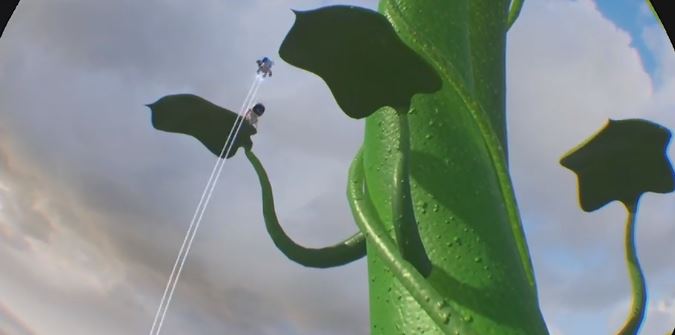These days, it’s rare to play a game with a crystal clear sense of purpose. With Astro Bot: Rescue Mission, Sony’s Japan Studio set out to prove that 3rd-person VR platformers can be great. Luckily for us gamers, they did a bang-up job. In hindsight, this may seem like an obvious choice, but JS did more than just copy and paste Super Mario 64 into a VR space. Astro Bot: Rescue Mission is the first truly great game of its kind on PSVR. Though many things make AB:RM great, in my view its success rests on how Japan Studio thoughtfully designed the game specifically for VR.
The Player Is The Only Camera
Astro’s foot lasers help players line up tricky jumps.
Once Japan Studio made the decision to forgo the classic two-stick camera control for 3D platformers, they needed a replacement system. They soon realized that in order to utilize the full potential of VR, the player should act as the only camera. Instead of using the right stick to adjust the camera, they explored fun ways for the player to use their body. Perspective play encourages the player to lean and find surprises. Enemies or coins will peek out from behind walls, acting as hints to lean and look. Every level has moments like this because leaning compliments platforming well. Similarly, vertical play forces the player to look up and down. Oftentimes, Astro will fall to a platform way below the player, then after some action he will hit a jump pad and shoot up, pulling the player’s gaze along with them. . Translucent platforms above the player let them keep tabs on Astro at all times. Enemies will emerge from the sky or the dark depths of the ocean. Other enemies are stacked on top of each other creating intimidating battles.
Hey there little man
In addition to verticality and perspective, there are many moments where Astro comes nose to nose with the player. Near play like this where the player sees all the details of their little buddy is extremely powerful. One of my favorite moments took place in one of AB:RM’s water levels. Astro swam right up to my visor and actually got stuck to the glass. He awkwardly waved and giggled before swimming away. In contrast to near play, levels also include moments where you send Astro far off in the distance. Sometimes you send Astro into a long, narrow cave to rescue another little bot. Other times, Astro will walk on the outstretched arm of a giant robot as you move along with him. Moments like the giant robot sequence play like 2D platformers due to the removal of depth perception.
The last kind of play is 360 play encourages the player to turn around. These moments are used more sparingly because turning your head around isn’t comfortable for a lot of players. There is only a handful of moments where Astro must move behind you, otherwise most of the action takes place within a 180 degree field of view.
Bonding With Your Bot Buddy
In addition to styles of play that Astro encounters, the players themselves perform many actions and develop a bond with their little robot buddy. Players can see their own body in mirrors and shadows. The player robot’s body is stretchy and a joy to move around. Players often use their head during gameplay, like dodging traps or enemies, headbutting objects, and even blowing air using the headset’s microphone. Furthermore, players make eye contact with Astro himself. I must’ve giggled every time he looked at me with his big eyes and waved, which happens A LOT. Other NPCs, like flowers and enemies, also make eye contact with the player. The constant eye contact validates the player’s place in the world and reinforces the empathetic bond with Astro.
Go-Go Gadget Dualshock!
Players create platforms for Astro with shurikens.
The player’s head isn’t the only way they interact with astro and the environment, the controller also houses a handful of gadgets. Effectively, all gadgets are different kinds of guns. Players shoot water, shurikens, balls and even light. These aren’t just fun toys, but each gadget is a multipurpose compliment to platforming. Many levels use a hookshot that creates a tightrope that Astro walks on. Players bounce Astro by moving the controller up and down. In a dojo themed level, players sink shurikens into wooden conveyor belts to act as platforms for Astro. The gadgets allow players to approach platforming challenges in many creative ways.
Every art form struggles to adapt to new technology but inevitably, pioneers forge a path. Be it silent films to talkies or, more recently, 2D games to 3D games someone figures it out and lays a groundwork for the rest of the industry. For me, and many others I imagine, Astro Bot: Rescue Mission has shown a way forward for 3rd person games in virtual reality.



